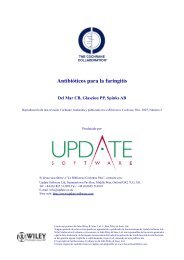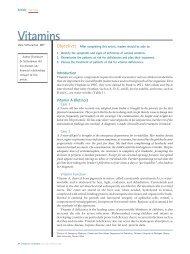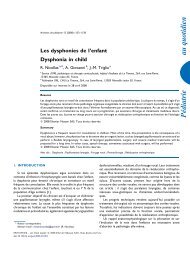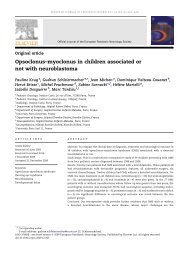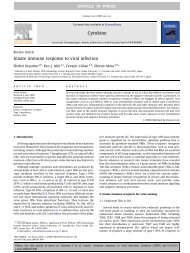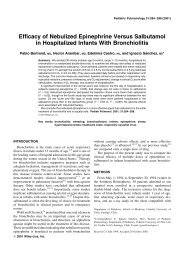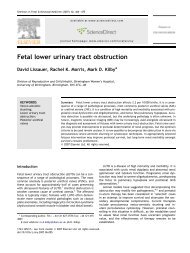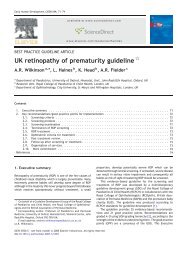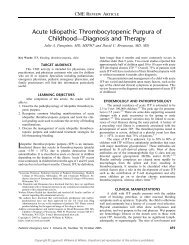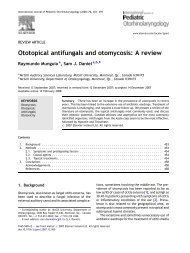Pertussis: a concise historical review including diagnosis ... - sepeap
Pertussis: a concise historical review including diagnosis ... - sepeap
Pertussis: a concise historical review including diagnosis ... - sepeap
You also want an ePaper? Increase the reach of your titles
YUMPU automatically turns print PDFs into web optimized ePapers that Google loves.
82 Reviews in Medical Microbiology 2005, Vol 16 No 3<br />
components, such as filamentous hemagglutinin, heatlabile<br />
toxin, agglutinogens, outer membrane proteins,<br />
and adenylate cyclase toxin, may also contribute to<br />
immunity after infection or vaccination [44–46]. In<br />
addition, it was recently shown that antibodies to pertactin,<br />
but not to pertussis toxin, fimbriae, or filamentous<br />
hemagglutinin, are crucial for phagocytosis of B. pertussis<br />
[47]. The immunogenicity of these substances may be<br />
significantly increased by the presence of pertussis toxin<br />
[48]. This synergism indicates that pertussis toxin could<br />
function as an adjuvant to a variety of protective antigens<br />
of B. pertussis. The defence mechanisms are both nonspecific<br />
(local inflammation, increase in macrophage<br />
activity, and production of interferon) and specific<br />
(proliferation of specific B and T cells) [49].<br />
The nature of immunity in whooping cough is, however,<br />
incompletely understood. A role for circulating antibody<br />
in immunity is indicated by the correlation between<br />
protection of human vaccinees and their antibody titres<br />
[44–46]. However, effective immunity does not necessarily<br />
depend on the presence of protective antibodies, and<br />
immunity to whooping cough may therefore be mediated<br />
essentially by cellular mechanisms [49,50]. This cellmediated<br />
immunity may be considered the crucial carrier<br />
of long-term immunity, and titres of specific humoral<br />
antibodies may diminish over time.<br />
Epidemiology<br />
Worldwide, B. pertussis causes some 20–40 million cases<br />
of pertussis per year, 90% of which occur in developing<br />
countries, and an estimated 200 000–400 000 fatalities<br />
each year [11,13,51]. Since the last decade many<br />
developed countries have experienced a re-emergence<br />
of pertussis, even countries that have had high vaccination<br />
coverage for many years. Because of waning natural and<br />
vaccine-induced immunity older children and adults are<br />
susceptible to infection again. Therefore it is assumed that<br />
infection frequency is probably highest in adolescents and<br />
adults and consequently those age groups are the main<br />
source of infection for infants [52].<br />
In many countries there has been an increase in the<br />
incidence of B. pertussis infection since the 1990s [53–<br />
57]. In the Netherlands in 1989–1994 the mean<br />
incidence on the basis of notification and serology was<br />
2.4 and 2.3 per 100 000 per year. In 1996 for example,<br />
there was in the Netherlands a steep increase in<br />
notifications (27.3/100 000), positive serology, hospital<br />
admissions and even deaths [57–59]. Since then the<br />
incidence has remained higher than before 1996 (Fig. 1).<br />
Although in older literature there are reports of reinfection<br />
with whooping cough, there are no reports on<br />
proven re-infection [41,60–64].<br />
Changes in vaccination coverage, vaccine quality or<br />
accuracy in reporting have been excluded as possible<br />
causes for the increase in incidence. However, there have<br />
been adaptations of B. pertussis to the vaccine. Notable<br />
changes in the variety of B. pertussis strains were found<br />
between the populations from the prevaccination era and<br />
the subsequent period. The reduction in genotypic<br />
diversity in the 1960s and 1980s was associated with the<br />
expansion of antigenically distinct strains, different from<br />
Fig. 1. <strong>Pertussis</strong> in the Netherlands from 1989 to 2004: notifications, positive two-point serology, positive one-point serology;<br />
hospital admissions from 1996 to 2004, based on first day of illness [52]. Note: Before 1996 all serological tests for pertussis were<br />
performed at the LIS-RIVM. However, since 1998 at least three of the 16 regional Public Health Laboratories and also some other<br />
(hospital) laboratories have started to perform serology with commercial available assays. Consequently, the population coverage<br />
of serological surveillance based on serological data of LIS-RIVM is now estimated to have decreased from 100% in 1996 to less<br />
than 50% in 2002.




